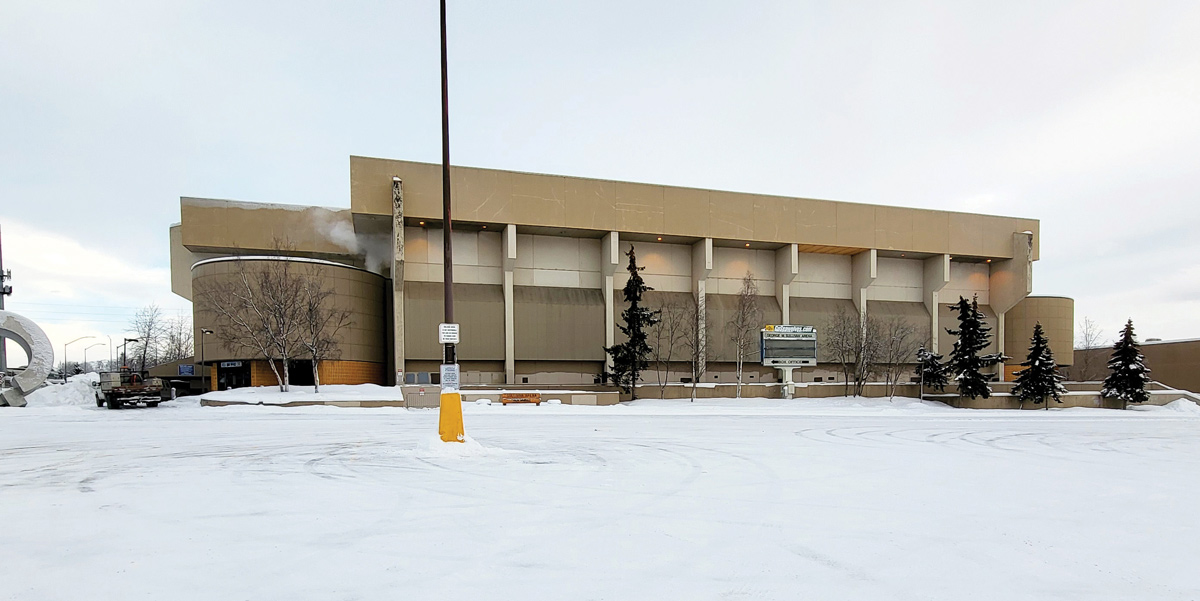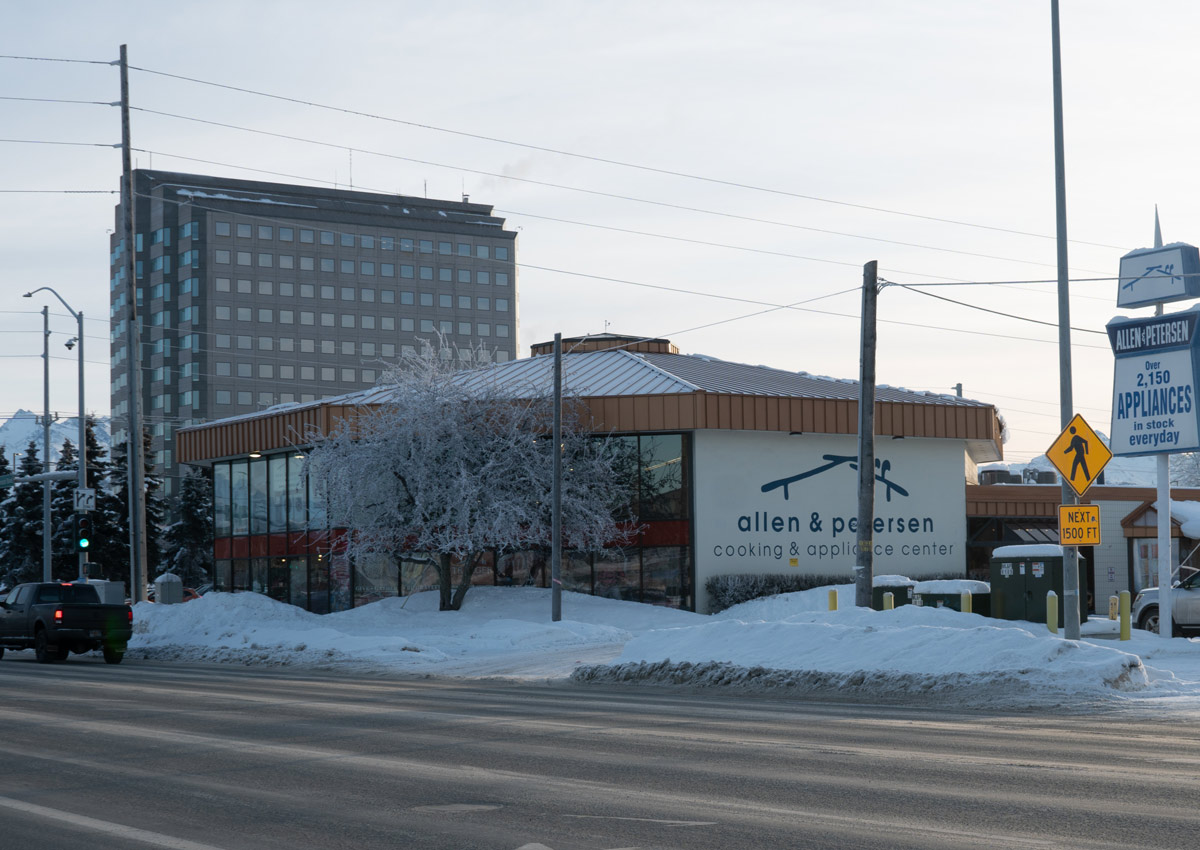omelessness was a business-related issue that Brittani Clancey, the owner of FashionPact, dealt with daily when her resale boutique was located near downtown Anchorage. The thrift shop—which donates a percentage of its sales to local charities—served a variety of customers, including those experiencing homelessness. About half of these customers visited the store without any negative incidents; the other 50 percent were rude or intoxicated, says Clancey, who once had a shopper collapse from a medical emergency.
The homelessness situation not only elevated Clancey’s concerns about staff security but also reduced customer foot traffic, as some people did not feel safe shopping in the neighborhood. “I fear that our downtown will become similar to Seattle and San Francisco, and businesses will choose to relocate because they can’t afford the cost of operating downtown,” Clancey says.
In fact, FashionPact relocated from the area last February—primarily because the store’s roof collapsed. Now the business operates two shops: one off Dimond Boulevard and another on 68th Avenue. So far, neither location has had any difficulties related to homelessness, Clancey says.
People experiencing homelessness in Anchorage are particularly visible in the Downtown and Midtown areas. Negative issues associated with these individuals—also described as unhoused, unsheltered, houseless, or house-deprived—have had a significant effect on establishments like FashionPact. Consequently, business owners, community leaders, and various organizations are working together to alleviate the situation.

Anchorage Coalition to
End Homelessness
There is no exact census of how many Anchorage residents struggle with homelessness. One method is to count contacts with support services, explains Meg Zalatel, a member of the Anchorage Assembly and executive director of the Anchorage Coalition to End Homelessness (ACEH). “We have approximately 11,500 touches to the homelessness prevention system,” she says. “These are unique individuals who need everything from prevention to retention services. Of that, there is a subset of what we call those who are experiencing literal homelessness, those who are unsheltered, in an emergency shelter, or in transitional housing. That number is around 3,200; and of that 3,200, there are about 800 unsheltered individuals.”
Zaletel says the homelessness problem is not getting worse; it’s becoming more visible. She attributes much of the visibility to insights and refinements gained during the COVID-19 pandemic. “During COVID, we learned that people need shelter 24/7, and we have accepted that as the model,” she says. “Now we have more tools in our toolbox to approach it.”
ACEH favors the “housing first” model, which addresses root causes of an individual’s homelessness after putting a roof over their head. “What we do know is that housing works,” says Zalatel. “When we turned on the guest house services, there was a slight dip in homelessness.”
Patricia Morales | Alaska Business


First National Bank Alaska
Homelessness has ripple effects on the surrounding community, from retailers like FashionPact and Allen & Petersen Cooking & Appliance Center to financial institutions like First National Bank Alaska (FNBA). Businesses have safety concerns for employees and customers, says Kathleen McArdle, president and CEO of the Anchorage Chamber of Commerce. This is especially true if the individual experiencing homelessness is dealing with a mental health disorder or addiction. “That creates some really unpredictable scenarios,” she says. “I think the human concern is utmost.”
Theft and vandalism are also attributed to homelessness, according to Midtown Community Council President Kris Stoehner. Some businesses have lost more than $100,000—with one company losing $300,000 to $400,000—in the last three years due to these crimes. “We can substantiate a million dollars’ worth of theft and vandalism in Midtown from April 15 to July 1,” she says. “April 15 was the day the Sullivan Arena shelter opened [to the public after serving as an emergency shelter] and people started coming over to Cuddy [Family Midtown Park] and the National Archives site camp. Since that time, I truly believe there has been at minimum of another half million dollars’ worth of theft.”
While she has empathy for people living in the camps, Stoehner believes the city needs to prioritize law enforcement. “We’re pouring millions of dollars in housing, but we are not doing anything for mitigation,” she says. “We have to figure out a way that we can work with law enforcement—and not just police officers, but district attorneys, and judges… We’re in danger of losing businesses, as they cannot afford these losses.”
At FNBA, the impact of homelessness on its customers and employees is “immense and ongoing,” according to Property Manager Mike Bridges. The bank has a branch and operations center in the Eastchester neighborhood, across the street from the Sullivan Arena, which was pressed into service as a congregate shelter during the COVID-19 pandemic. Since the Sullivan Arena shelter closed on May 1, 2023, FNBA reports increased vandalism of windows and ATM lobbies, resulting in temporary closures, limited customer access, and costly emergency repairs. “All of this contributes to increased stress and anxiety for those working at the affected facility, resulting in decreased employee morale,” he says.
To address those concerns, Bridges says, “The bank has added extra security patrols, cameras, and door security hardware—further increasing operational costs. Moreover, the human resource and financial costs of cleaning up unsanitary conditions—including trash, drug paraphernalia, and other waste—are adding up. Unfortunately, these issues are not only affecting locations in Anchorage; we are experiencing the same issues at facilities throughout the state.”
As a community bank, FNBA is doing its part to ease the problem of homelessness, says James Estes, the bank’s information security officer and security manager. “First National invests in organizations that support our neighbors facing challenging life situations, including food insecurity, homelessness, and limited access to health and social services. Annually, the bank provides approximately $1 million in charitable donations and sponsorships, consisting of cash and in-kind contributions to youth, education, and essential emergency services.”
In recent years, the bank’s anti-poverty support has included workforce development through the Covenant House Covey Academy, the University of Alaska, and specific industry scholarships.

Carter Damaska | Alaska Business
Allen & Petersen Cooking & Appliance Center—which has operated in Anchorage for more than fifty years—encounters the effects of homelessness every single day. “We’ve certainly had vandalism, loitering, and lots of messes to clean up,” says President and CEO Kyle Mirka. The store is across the street from a busy Midtown corner where panhandlers gather.
The appliance center takes a compassionate approach, says Mirka, who previously served on a Midtown Community Council task force to address crime and vandalism. “We do not take a ‘not-in-our-backyard stance’ because we recognize that the problem has to be dealt with somewhere,” he says.
However, “Perhaps we make it a little bit too easy here in Anchorage to live a lifestyle of non-responsibility,” Mirka adds, while noting that it’s hard to label people. “There are some people who have just fallen on hard times and can be a contributing member of society.”

Anchorage Chamber of Commerce
As Mirka sees it, the problem is a lack of criminal enforcement. “Homelessness itself is not a crime, but homelessness can definitely lead to crime,” he says.
Kenny Petersen, Mirka’s co-owner in the shop, has tried to help as a member of ACEH and as a community activist. Petersen promotes using a “good neighbor” model to mitigate homelessness. The model, based on the Good Samaritan story, advocates everyone in the community working together to meet the comprehensive needs of unhoused individuals.
His vision is for the city government and ACEH to create a coordinated way for the public, businesses, faith organizations, and others to better utilize resources. “Businesses could provide jobs and job training, including stipends; church and faith organizations could provide relationships; and communitycouncils could adopt an area and take responsibility rather than send people away,” Petersen says.
Petersen’s approach would encompass everything from housing and healthcare to employment and educational needs, maintaining ongoing assistance through what he calls a benevolence fund. “So you are paying for your neighborhood; it’s neighbors taking care of neighbors,” he says.

Joshua Lowman
Anchorage organizations are using diverse strategies to address homelessness. For instance, ACEH created its Anchored Home 2023-2028 plan with various partners. The five-year strategic plan focuses on increasing the supply of and equitable access to affordable housing. ACEH also launched a Built for Zero movement to make homelessness a rare, brief, and one-time event.
Recently, ACEH introduced a Next Step policy, implementing certain facets of its Anchored Home plan. Next Step borrows tactics that have worked in Houston, Texas and applies them to Anchorage—with a seasonal twist. The Houston model, recognized as the gold standard, involves transitioning people from cold weather shelters into more stable and cost-effective permanent housing.
One of ACEH’s major achievements is an award-winning project to convert three hotels to housing, resulting in more than 270 housing units. And in June 2022, it transformed a fourth hotel into a complex care shelter with eighty-six beds. The Municipality of Anchorage provided funding and other support for the hotel conversions. “I feel like we are working in really great coordination,” Zaletel says. “I think that keeping the course and staying housing-focused and collaborating is what the city should be doing—from prevention to providing permanent housing.”
Stoehner feels that Anchorage’s problem with homelessness is more extensive than a lack of housing, though, and the city is not addressing the core issue. “I don’t believe in giving free housing to people without some kind of responsibility on the part of the tenant,” she says. Placing people in a hotel room doesn’t solve the underlying addiction or mental health problems, in her view.
The Midtown Community Council is focusing on what it considers the root of the problem. In October, a strategic planning session with business and community leaders dealt mainly with reducing crime and vandalism. Meeting attendees outlined suggestions such as increased state and local funding for detox beds, a navigation center to route people to services, and increased funding for outreach and case management.
The Anchorage Chamber of Commerce created a Community Care Kit to help businesses navigate crisis situations. “It’s a way to help with the response in a reactive scenario,” McArdle explains. “It’s not intended to be the solution, but it can start a conversation with helping business leadership and employees with how to recognize and respond to crises.”
The Community Care Kit is a digital document that covers how to help someone who might be experiencing a mental health crisis. “This is a great framework for how to respond or direct resources if you, a community member, friend, coworker, or customer have questions about challenging issues, such as homelessness,” McArdle says.
Joshua Lowman

Members of the business community have distinct views about the role they feel the Municipality of Anchorage should play. For instance, Mirka says, “I think this is a very delicate balance because I am a human being, and I do have compassion for individuals. I also believe our city goes so far to assist and aid those in challenging times that we may make it easy for the individuals going about their life. I have heard of people relocating to Anchorage because of the free shelters that we offer for the winter.”

First National Bank Alaska
Petersen feels the solution requires a completely new approach. “But I don’t think it will be through the nonprofits or government because they are already out of money,” he says. “It will take New Connections, the utopian pilot project I have in mind for connecting faith communities.”
FNBA encourages the Municipality of Anchorage to take “meaningful and immediate action” to provide safe shelter for the unhoused population. “Homeless individuals who are down on their luck or facing difficult circumstances deserve compassion, understanding, and support as they navigate challenging times,” Estes says.
At the same time, improving safety and reducing crime are important factors to businesses, Estes says. FNBA is stepping up to provide space for an Anchorage Police Department substation at its Eastchester campus. “The annual lease rate is $10 per year,” he says. “Although no police activity will take place at the Midtown substation, the space will offer officers a convenient location to take a break and catch up on their paperwork while being able to respond to any emerging neighborhood needs quickly.”
A collaborative effort of the business community, local government, nonprofit entities, and other organizations can ultimately lead to positive outcomes; the effects of homelessness are far reaching, and any potential solutions will require the same scale.